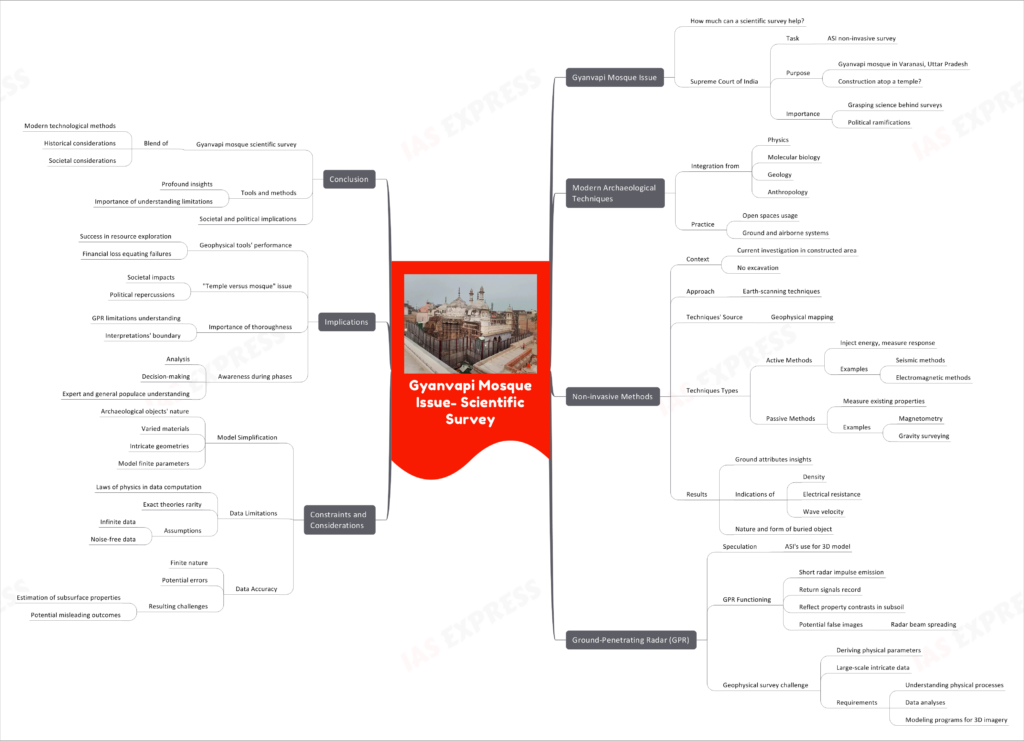Gyanvapi Mosque Issue- How much can a Scientific Survey Help?

On August 4, the Supreme Court of India tasked the Archaeological Survey of India (ASI) with a detailed non-invasive survey of the Gyanvapi mosque in Varanasi, Uttar Pradesh. The survey aims to discern whether the mosque was constructed atop a temple. Given the significant political ramifications, it’s pivotal to grasp the science behind such surveys.

This topic of “Gyanvapi Mosque Issue- How much can a Scientific Survey Help?” is important from the perspective of the UPSC IAS Examination, which falls under General Studies Portion.
Modern Archaeological Techniques
- Archaeology has integrated techniques from:
- Physics
- Molecular biology
- Geology
- Anthropology
- Commonly, archaeologists have the freedom to use open spaces, employing both ground and airborne systems.
Non-invasive Methods
- Given that the current investigation occurs within a constructed area with no excavation permitted, the approach relies on earth-scanning techniques.
- The techniques, primarily derived from geophysical mapping, can be:
- Active Methods: Inject energy into the ground and measure the response. Examples include seismic and electromagnetic methods.
- Passive Methods: Measure pre-existing physical properties, like magnetometry and gravity surveying.
- Both methods yield insights into the ground’s attributes such as density, electrical resistance, and wave velocity, which can indicate the potential nature and form of a buried object.
Ground-Penetrating Radar (GPR)
- Media speculates ASI’s use of GPR to generate a 3D model of underlying archaeological structures.
- How GPR works:
- Emits a short radar impulse from a surface antenna.
- Records return signals reflecting property contrasts in the subsoil.
- Radar beam spreading can lead to false images, as part of the signal might not correspond to the physical size of the subsurface object.
- The geophysical survey’s challenge lies in deriving physical parameters from the intricate and large-scale data acquired. Thus, data requires:
- Understanding of physical processes
- Robust data analyses and modeling programs for accurate 3D imagery.
Constraints and Considerations
- Model Simplification: Archaeological objects, comprised of varied materials with intricate geometries, are typically simplified into models with specific, finite parameters.
- Data Limitations: Laws of physics aid in data computation based on a model. However, exact theories are rare. Assumptions often include infinite and noise-free data.
- Data Accuracy: Data tends to be finite and possibly contains errors, leading to potential estimation challenges for the subsurface’s physical property distribution. This can result in inconclusive or misleading outcomes.
Implications
- While geophysical tools boast commendable success rates in resource exploration, failures usually equate to financial loss.
- A “temple versus mosque” query is vastly different, touching on deep-seated emotions, societal impacts, and political repercussions.
- Ensuring thoroughness is paramount. Techniques like GPR possess inherent limitations, and interpretations should stay within those bounds.
- During the analysis and decision-making phases, experts and the general populace should remain aware of these constraints.
Conclusion
The scientific survey of the Gyanvapi mosque involves a blend of modern technological methods with historical and societal considerations. While the tools and methods employed offer profound insights, understanding their limitations is equally crucial, especially given the survey’s potential political and societal implications.
Practice Question for Mains
How far can scientific surveys help in resolving the Gyanvapi mosque case? Examine. (250 words)
